





















































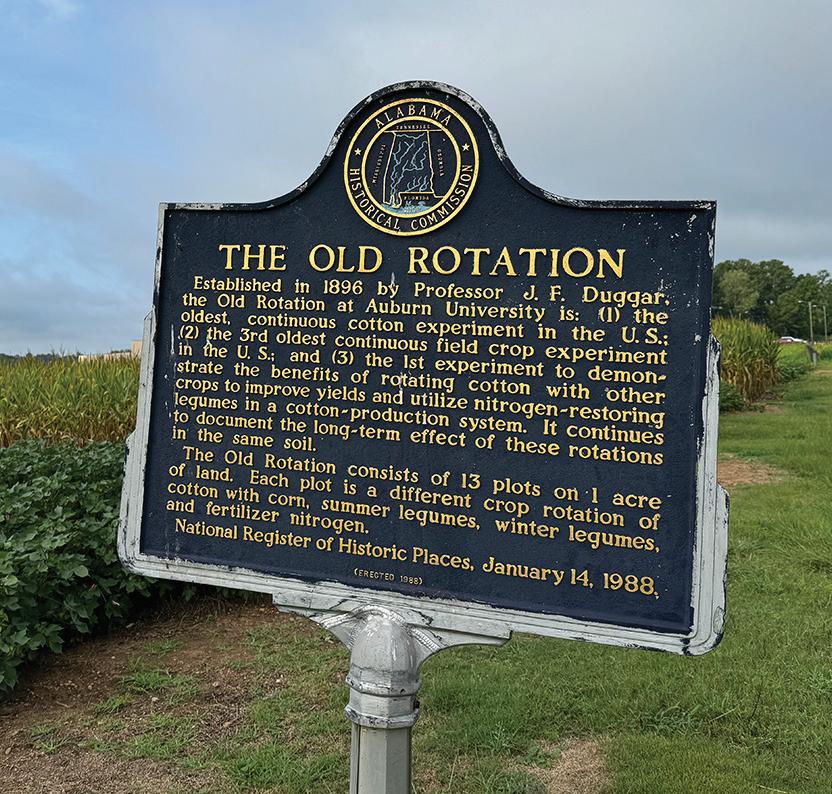
























































At Auburn University in East Central Alabama stands two of the oldest cotton experiments in the world. The Old Rotation remains the third-oldest rotational study in the world and oldest in the South, while Cullars Rotation is the oldest soil fertility study in the South. Dr. Audrey Gamble, Auburn University, has oversight of the rotation studies, and Joseph Burch, Auburn University, performs day-to-day management.
e Rio Grande Compact is not black and white. Texas and New Mexico are taking groundwater pumping to the courts.
TALT is dedicated to the conservation of working lands and preserving part of Texas’ natural heritage.
Zachary Treadway knew he wanted a life in agriculture as an agronomist, working with producers throughout the Arkansas Delta and beyond.
LSU AgCenter says updated, lower seeding rates have the potential to save growers money.
Dusty Findley provides an update on rules to protect workers from heat injury and illness.
ON THE COVER: Auburn University’s Dr. Aubrey Gamble and



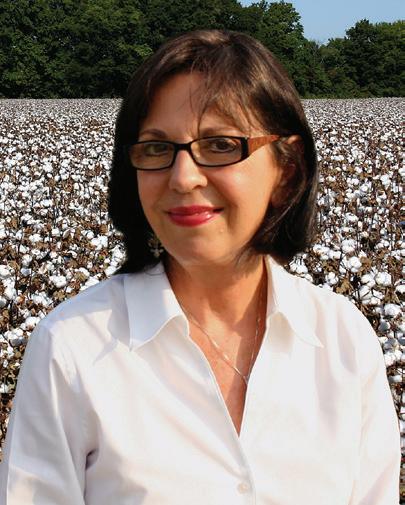
Carroll Smith
Every five years, U.S. Department of Agriculture’s National Agricultural Statistics Service’s Census of Agriculture publishes the data they have collected at the national, state and county levels. It presents a multitude of reports that include such topics as number of farms, irrigated acreage and producer characteristics.
I recently ran across an article by Jamey Menard in Southern Ag Today titled Changes in Average Age of Producers in Southern States, 2017 and 2022. Menard is research leader, University of Tennessee Department of Agricultural and Resource Economics.
“One metric tracked is the average age of agricultural producers,” Menard said. “This information is provided for selected southern states for the Census reporting periods 2017 to 2022, along with the percentage change in average age for that time frame.
“In all (southern) states, average producer ages were increasing. For 2022, Mississippi and Florida had the highest average ages of producers at 59.6 and 59.5 years old, respectively. Georgia, Kentucky and Tennessee had the largest percent change increases in average ages from 2017 to 2022. North Carolina had no change.”
Since these are “average” ages, that indicates to me there are both older and younger farmers in the mix to come up with these median numbers. This represents a combination of folks who used to “let their fingers do the walking” through the Yellow Pages and those who grew up “letting their thumbs do the talking” via text messages.
If a farm is multi-generational, as many in the South are, it can draw on years of practical experience from the older farmers while taking advantage of new ag technology the younger entities are eager to explore and weave into the operation. To borrow a cliché, the range in ages is “a win-win for everyone.”
Another consideration is that farming involves a wide spectrum of inputs to be successful. The younger farmers, in general, can provide robust physical labor required for many day-to-day tasks, while the older farmers can provide operating capital that has been accumulated through the years. They appear to complement one another.
If you would like to review the 2022 Ag Census numbers for yourself, please check them out online at https://www.nass.usda.gov/Publications/ AgCensus/2022/.
If you have comments, please send them to: Cotton Farming Magazine, 7201 Eastern Ave., Germantown, TN 38138.
EDITORIAL/PRODUCTION
Editor Carroll Smith csmith@onegrower.com
Southeast Editor Amanda Huber ahuber@onegrower.com
Associate Editor Cassidy Nemec cnemec@onegrower.com
Digital Content Editor Katie Guthrie
Art Director Ashley Kumpe
Publisher/Vice President Lia Guthrie (901) 497-3689 lguthrie@onegrower.com
Associate Publisher/Editor-In-Chief Carroll Smith (901) 326-4443
Associate Publisher/Sales Scott Emerson (386) 462-1532 semerson@onegrower.com
Production Manager David Boyd dboyd@onegrower.com
Audience Services Kate Thomas (847) 559-7514
For subscription changes or change of address, call (847) 559-7578 or email cottonfarming@omeda.com
EDITORIAL ADVISORY BOARD
David Burns – North Carolina
David Lynch – South Carolina
Bob McLendon – Georgia
Larkin Martin – Alabama
Mike Sturdivant Jr. – Mississippi
Charles Parker – Missouri
Jimmy Hargett – Tennessee
Allen Helms – Arkansas
Jay Hardwick – Louisiana
Ronnie Hopper – Texas
Ron Rayner – Arizona
John Pucheu – California
Mike Lamensdorf President/treasurer Lia Guthrie Publisher/Vice President
ACKNOWLEDGEMENT OF COOPERATION: Cooperating with COTTON FARMING are various cotton producer organizations across the Cotton Belt. Many representatives of producer organizations serve on COTTON FARMING’s editorial advisory board. Opinions expressed and conclusions reached by contributors are not necessarily those of the cooperating organizations or the editors. All statements, including product claims, are those of the person or organization making the statement or claim. The publisher does not adopt any such statement or claims as its own and any such statement or claim does not necessarily reflect the opinion of the publisher.
Copyright 2024 ©
ASSOCIATED PUBLICATIONS – One Grower Publishing, LLC also publishes RICE FARMING, THE PEANUT GROWER, SOYBEAN SOUTH and CORN SOUTH.
One Grower Publishing, LLC 875 W. Poplar Ave., Suite 23, Box 305 Collierville, TN 38017
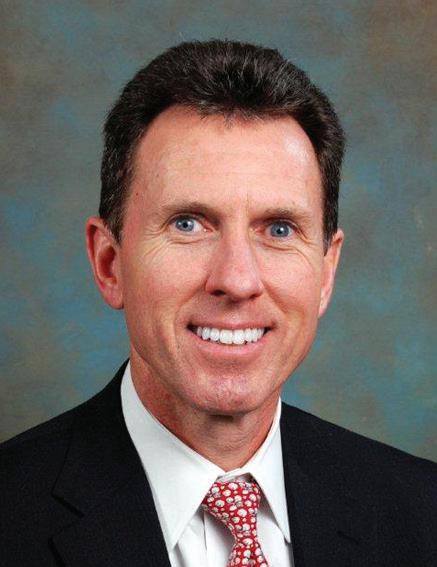
Gary Adams

Among challenges to the U.S. cotton industry’s competitiveness are securing an improved safety net for producers, making inroads against increased competition from manmade fibers, and navigating post-pandemic economic pressures.
■ Since implementation of the 2018 Farm Bill, cotton producers have faced mounting economic challenges due to increased competition from manmade fibers and reduced consumer spending power amid post-pandemic inflation. The USDA’s August 2024 World Agricultural Supply and Demand Estimates (WASDE) report projects world cotton consumption for the 2024/25 marketing year at 116.2 million bales, down 2.8 million bales from 2018/19. Concurrently, China’s polyester production has increased by 35.5 million bales since 2018, making it nearly twice the size of the world cotton market.
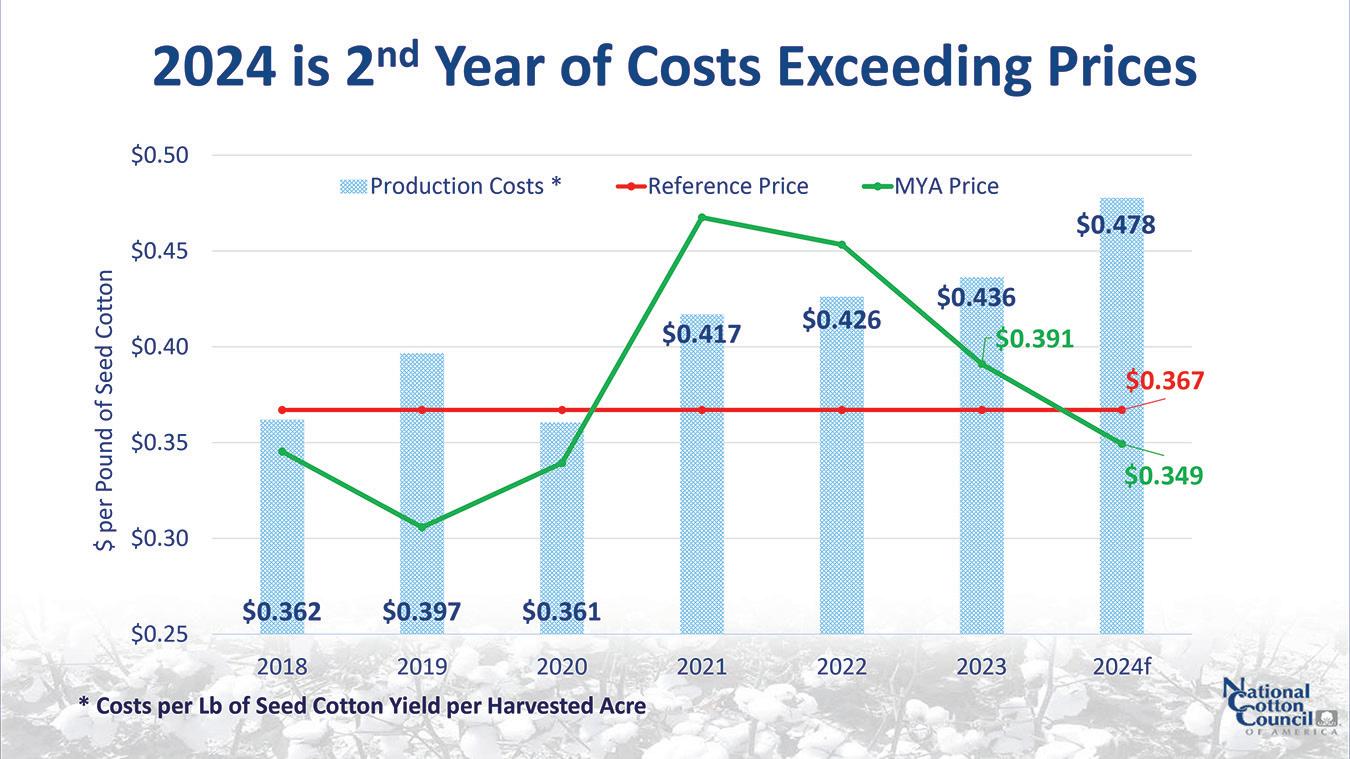
U. S. cotton also faces competition from increased cotton production in Brazil and Australia, which have significantly boosted their exports. Collectively, the two countries are exporting 18 million bales, more than double their trade level from a decade ago. Consequently, the U. S. share in world cotton trade has dropped from 36% to 28% since the 2018 Farm Bill.
Cotton prices have fallen to their lowest since early 2020, while production costs have increased significantly over the life of the Farm Bill. The USDA estimates total production costs of $902 per acre for 2024, an increase of $193 per acre since 2018. The
cost per pound of seed cotton for 2023 is $0.436, calculated from total costs of $883 and a yield of 2,023 pounds per acre. For 2024, with a projected lint yield of 828 pounds and cottonseed yield of 1,043 pounds, the cost per pound is expected to rise to $0.482, which is over 11 cents higher than in 2018. Current production costs are well above both the statutory reference price of $0.367 and the seed cotton market year average (MYA) price.
The projected seed cotton price for the 2024 marketing year is $0.341, based on a weighted average of USDA’s forecasts of $0.66 per pound for cotton lint and $0.1025 per pound for cottonseed.
■ Despite increased production costs, strong market prices in 2021 and 2022 allowed profitability, but declining prices in 2023 led to financial shortfalls unless producers were fortunate enough to have yields well above average levels. For 2024, costs and prices are moving in opposite directions, worsening the financial situation for cotton producers. USDA projects per-pound costs will hit an all-time high, greatly exceeding both market prices and the farm bill safety net.
Across the Cotton Belt, many farms suffered losses in 2023, and they were only able to secure 2024 production financing through either liquidating a portion of their assets or seeking financing from non-traditional sources. Now, these family farming operations are facing a second year of economic losses, with little hope for recovery in 2025. The National Cotton Council will be seeking every opportunity to build awareness of the current economic situation and pursuing multiple avenues for boosting the safety net for cotton producers. For some families continuing their generational family farms may be an unattainable dream without economic assistance from Washington.
Gary Adams is president/CEO of the National Cotton Council of America.
BY TIFFANY LASHMET AND JESSE RICHARDSON
On June 21, 2024, the United States Supreme Court issued an opinion in the long-running dispute between Texas and New Mexico over the 1938 Rio Grande Compact. The Court, in a 5-4 decision, held that the federal government could block an agreement between Texas and New Mexico to resolve their dispute. Although the compact relates to the river, the dispute centers on groundwater pumping.
Texas filed suit against New Mexico in 2013, alleging that excessive groundwater pumping in New Mexico deprived Texas of its fair share of Rio Grande water under the compact. Note that lawsuits between states originate in the United States Supreme Court. The Court appoints a Special Master to hold hearings and make recommendations to the Court, which ultimately decides the issues.
Unlike most compacts, the Rio Grande Compact requires New Mexico to deliver water not to the New Mexico/Texas border, but to Elephant Butte Reservoir, a federal project about 100 miles north of the border. Texas alleged that groundwater pumping along the river between the Elephant Butte Reservoir and the state line took water from the river that rightfully belonged to Texas.

The federal government filed a motion to intervene in the litigation in 2014, alleging that its interest in the federal project at Elephant Butte allowed intervention to protect the government’s rights and obligations. The federal government, through Downstream Contracts, was required to deliver water to an irrigation district in New Mexico and one in Texas.
The Court allowed the federal government to intervene, a relatively rare occurrence, because of the unique circumstances of the case and the fact that its interests aligned with those of Texas.
Texas’ lawsuit focused on increased groundwater pumping between the Elephant Butte Reservoir and the state line. While the federal government had operated the reservoir based on data from 1951 to 1978 (“D2 data”), a time period where groundwater pumping increased significantly in New Mexico, Texas asked for allocations to be based on 1938 data, when there was much less groundwater pumping in New Mexico. The United States, which had operated based on the latter for decades, did not request a change.

After 10 years of hearings and litigation, Texas and New Mexico agreed on a consent decree, settling the issues between the states. The agreement continued water allocations based on the D2 period, which favors New Mexico, but measured the water delivery at El Paso, which favors Texas. Complex accounting measures in the agreement ensured that Texas would receive the state’s fair share of water.
However, the federal government objected to the agreement, claiming that its interests in administering the water project were threatened. In addition, for the first time, the federal government claimed that the water allocation should be based on 1938 levels of groundwater withdrawals. New Mexico estimates that a forced reduction in groundwater withdrawals to 1938 levels would mean a loss of 50,000 jobs and 10% of the state’s gross domestic product.
Justice Jackson, joined by Chief Justice Roberts and Justices Sotomayor, Kagan and Kavanaugh wrote the majority opinion. The majority found that the federal government had independent claims that would be resolved by the agreement. Given that the government was now a party, the agreement could not resolve the government’s interests without its consent. Since the government’s interests were aligned with those of Texas, and Texas had requested a 1938 baseline, the government was deemed to make a similar request. Given the close connection between the compact, the federal project and the irrigation contracts, the government must agree to any resolution of the case.
Justice Gorsuch, who also authored the Court’s 2018 unanimous opinion allowing the United States to intervene, wrote the
dissenting opinion, and was joined by Justices Thomas, Alito and Barrett. The dissenters summarized their position as follows:
The Court’s decision … defies 100 years of this Court’s water law jurisprudence. And it represents a serious assault on the power of States to govern, as they always have, the water rights of users in their jurisdictions. The Special Master issued a detailed 115-page report laying all this out. His views were wise, his recommendations sound, and, respectfully, we should have done as he suggested.
The dissenters opine that the Court denied the entry of the consent decree “[b]ecause the federal government demands as much.” In addition, the federal government could not assert these claims alone in the Court but would have to file a lawsuit in the lower court.
Given the number of federal water projects in the United States, and increasing disputes between surface water and groundwater users, this decision could allow the federal government to take control of groundwater allocations in a large number of situations. Groundwater users generally lose these disputes because groundwater withdrawals generally began after surface water withdrawals.
Since the surface water users have seniority, surface water withdrawals receive priority. The decision may cause large cuts in groundwater withdrawals in New Mexico, as well as put groundwater users in jeopardy wherever federal water projects exist.
As in this case, the competing uses will likely include large agricultural users. New Mexico and Texas will now have to start back at square one.
Tiffany Lashmet is associate professor and Extension specialist agricultural law with Texas A&M AgriLife Extension. Jesse Richardson is professor of law lead land use attorney with West Virginia University.

BY SHELBY SHANK TEXAS FARM BUREAU FIELD EDITOR
The Texas Agricultural Land Trust (TALT) is dedicated to the conservation of working lands and preserving part of Texas’ natural heritage.
Texas’ privately-owned farms, ranches and forestlands account for 141.5 million acres, which is about 82% of the state, according to TALT.
However, Texas leads the nation in the loss of rural lands.
“We’re losing land so quickly to urban development and land fragmentation where these large ranches are being broken up and sold in smaller tracks,” Russell Marshall, chairman of the board of TALT, said in an interview with the Texas Farm Bureau Radio Network.
Texas is losing about 26.6 acres of land per hour, Marshall said. The loss has economic, social and environmental consequences, threatening Texas’ position as a food producer, sources of drinking water and privately managed habitat.
Preserving A Legacy
TALT was created by farmers and ranchers for farmers and ranchers to bring landowners tools and resources needed to achieve their goals of productivity, sustainability and legacy preservation.
“Conservation easements, especially on
Texas working lands, are extremely important in the state of Texas,” Marshall said.
A conservation easement is a voluntary legal agreement allowing landowners to retain title and management of their property, while forfeiting, donating or selling certain development rights to a land trust. This protects the land from commercial or residential development, preserves habitat, limits subdivision and fragmentation of the land, and allows landowners to ensure the land they love is protected into perpetuity.
“I’m a sixth-generation Texan. My family’s owned land in South Texas since 1910. I’ve seen agricultural lands lost to the growth our state is seeing,” Marshall said. “I’ve never lost sight of the fact that I grew up a ranch kid, and I want my children to be able to grow up ranch kids, and I want my grandchildren to be able to grow up ranch kids. This is one way that we can do that.”
TALT is the only land trust in the state focused on conserving Texas’ heritage of agricultural lands, wildlife habitats and natural resources.
“One of the things that’s so important for Texas is to keep Texas agricultural working lands where they need to be in farmers’ and ranchers’ hands and doing what they’ve always done,” Marshall said.
For more information, visit www. txaglandtrust.org.
The Texas Agricultural Land Trust (TALT) was created by landowners for landowners. Here is how the organization describes itself:
“Land defines us as Texans. It embodies our frontier spirit, can-do attitude and rugged individualism that centuries later makes us who we are. Concerned that Texas is losing its rural lands faster than any other state in the country, leaders of Texas’ statewide agricultural, wildlife and landowner organizations — Texas and Southwestern Cattle Raisers Association, Texas Wildlife Association and Texas Farm Bureau — came together in 2007 to create the Texas Agricultural Land Trust.
“With a Board of Directors who, as landowners themselves, understand the day-to-day challenges of owning and managing land, TALT continues to promote the conservation of open space, native wildlife habitats and natural resources of Texas’ private working lands. Created by farmers and ranchers for farmers and ranchers, TALT is proud to play a role in conserving part of Texas’ legacy of wide open spaces.
“The land trust accreditation seal is a mark of distinction in land conservation. Accredited land trusts meet national quality standards, uphold the public trust and ensure that conservation efforts are permanent.”
The 2023 Georgia Quality Cotton Awards were presented at the 2024 Georgia Cotton Commission Mid-Year Meeting on July 24. The awards are co-sponsored by the Georgia Cotton Commission and Bayer Crop Science/Deltapine and administered by the University of Georgia Cotton Team. Yangxuan Liu from the UGA Cotton Team conducted the analysis and presented the awards at the event in Statesboro.
The purpose of the awards is to recognize producers and ginners of high-quality cotton fiber and to identify their general management practices for the benefit of other growers. The producers and their gins received a plaque, and the winning producers received a $500 cash award. The UGA county Extension agent for each winner was also recognized as they work closely with the farmers during the growing season.
The awards are given in each of these three cotton acreage categories: 1) less than 500 acres, 2) 500 to 1,000 acres and 3) greater than 1,000 acres within the four regions of the state. Winners in these categories are determined by the loan value and premiums of their cotton. The winners’ excellent achievements are due largely to their management practices and expertise. The sponsors of this program congratulate the following winners:
Region 1
• Less than 500 acres
Grower: MGB Farms, Pulaski County
Ginner: Heart of Georgia Peanut & Gin, Hawkinsville
Nominated by: Jay Porter
• 500-1000 acres
Grower: Melissa Cape Farms, Pulaski County
Ginner: Heart of Georgia Peanut & Gin, Hawkinsville
Nominated by: Jay Porter
• 1000+ acres
Grower: WB Cape Farms, Pulaski County
Ginner: Heart of Georgia Peanut & Gin, Hawkinsville
Nominated by: Jay Porter
Region 2
• Less than 500 acres

Grower: Dickens Farms, Inc., Oconee County
Ginner: Bostwick Gin, Bostwick
Nominated by: Carsen Dean & Lucy Ray
• 500-1000 acres
Grower: Bill Godowns, Jefferson County
Ginner: Farmer’s Gin and Storage, Wadley
Nominated by: Pamela Sapp
• 1000+ acres
Grower: Dean Johnson, Burke County
Ginner: Bryant’s Inc., Bartow
Nominated by: Cliff Collins & Peyton Sapp
Region 3
• Less than 500 acres
Grower: Tommy Kenny, TFK In. Farms, Lowndes County
Ginner: B.C.T. Gin Company, Inc., Quitman
Nominated by: Joshua Dawson
• 500-1000 acres
Grower: Lee and Cole Ballard Farms, Brooks County
Ginner: B.C.T. Gin Company, Inc., Quitman
Nominated by: Will Brown
• 1000+ acres
Grower: Johnson Farms, Cook County
Ginner: B.C.T. Gin Company, Inc., Quitman
Nominated by: Tucker Price
Region 4
• Less than 500 acres
Grower: Jonathan Hart, Thomas County
Ginner: Boston Gin, Boston
Nominated by: Sydno Ingram & Michasia Dowdy
• 500-1000 acres
Grower: Patterson Farms, Worth County
Ginner: Worth Gin & Warehouse, Inc., Sylvester
Nominated by: Scott Carlson
• 1000+ acres
Grower: M & G Farms, Worth County
Ginner: Worth Gin & Warehouse, Inc., Sylvester
Nominated by: Scott Carlson
The overall Best Cotton Award was awarded to the Georgia cotton producer with highest loan value and premium. The 2023 Best Cotton Award went to Oconee County’s Dickens Farm, Inc. with a loan value of 57.81 cents/lb and a premium of 5.81 cents/lb.
The Georgia Cotton Commission provided this information.
BY CASSIDY NEMEC ASSOCIATE EDITOR
On the campus of Auburn University in East Central Alabama stands two of the oldest cotton experiments in the world. The Old Rotation remains the third-oldest rotational study in the world and oldest in the South, while Cullars Rotation is the oldest soil fertility study in the South.
Today, the Old Rotation and Cullars Rotation is managed by Auburn University Department of Crop, Soil and Environmental Sciences, the Alabama Agricultural Experiment Station and USDA-ARS National Soil Dynamics Laboratory. Dr. Audrey Gamble, associate professor for soil fertility and soil conservation at Auburn University, has oversight of the rotation studies, and Joseph Burch, research assistant at Auburn University, performs day-to-day management.
Support for both rotational studies is provided by Alabama Wheat and Feed Grains Committee, Alabama Soybean Producers and Alabama Cotton Commission.
The Old Rotation
By the time the late nineteenth century rolled around, much of the arable land was cleared for cotton and corn production in the South. Minimal to no lime or fertilizers were used at that point, and most farmers had been practicing “slash and burn” agriculture, exhausting the fields and moving on to other lands.
Established in 1896, the “Old Rotation” is the oldest continuous cotton experiment in the world and encompasses multiple cropping systems — cotton, corn, soybeans, small grains and winter cover crops all on one acre of sandy loam soil.

J.F. Duggar, a young professor at the then called Agricultural and Mechanical College of Alabama, proposed the theory that “Alabama agriculture would come into its own when her fields are green in winter.” Enter cover crops. He began to experiment on campus, and the Old Rotation he began then is still going strong today.
The purpose of the rotation is to demonstrate and document the value of rotating cotton with other crops and including nitrogen-restoring legumes in the system.
One of the plots has had continuous cotton and no fertilizer since 1896. “One
of the most amazing things to me about this is that this plot has been in continuous cotton with no nitrogen for over 125 years, and it still picks about a bale,” Gamble said. “We’ve seen an increase in yields over time. With a legume, we are able to see more of that yield potential.” Gamble said there is one rotation plot that stands above the rest and has proven to have the highest yield potential over time. “Our highest [yields] are certainly the cotton-corn rotations with the winter legume; they tend to do the best.”
Visit https://agriculture.auburn.edu/ research/cses/the-old-rotation/ for more information on The Old Rotation.
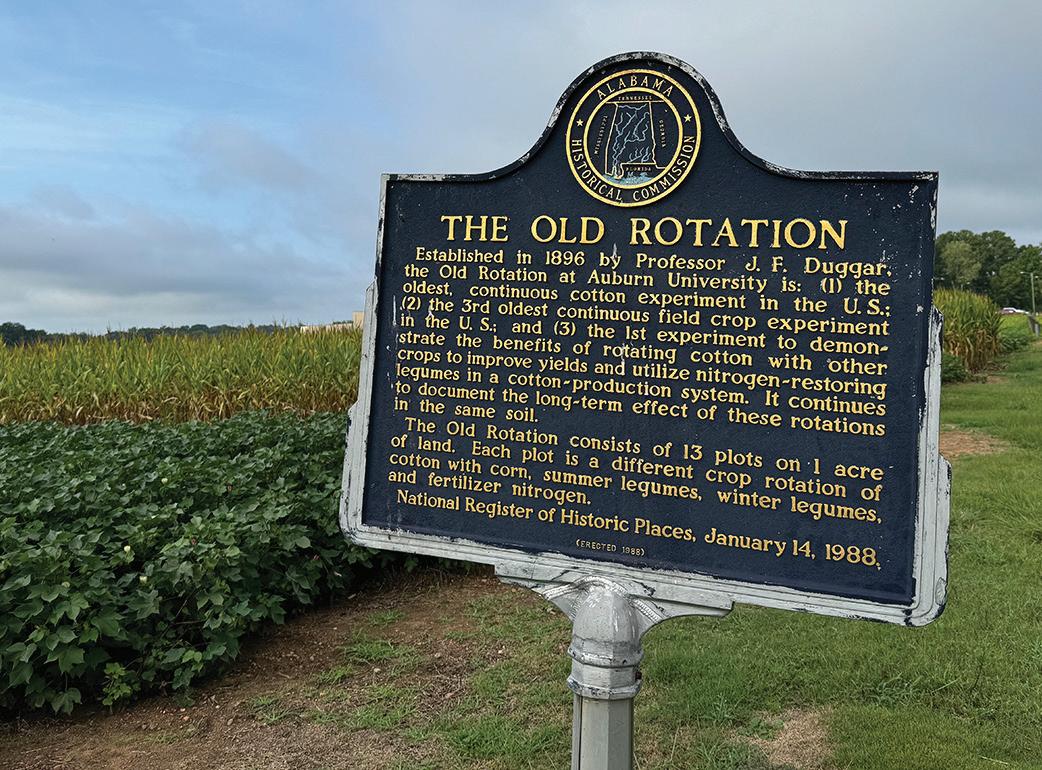

Established in 1896, the “Old Rotation” (le ) is the oldest continuous cotton experiment in the world and encompasses multiple cropping systems — cotton, corn, soybeans, small grains and winter cover crops all on one acre of sandy loam soil. e Cullars Rotation, the world’s second oldest cotton study, was established on campus in 1911.
The Cullars Rotation
The Cullars Rotation, the world’s second oldest cotton study, was established on campus in 1911. It was named after Mr. J.A. Cullars who farmed the land where the rotation sits with his brother John Alvis.
Professor George Atkinson, a biologist at the Agricultural and Mechanical College of Alabama experimented on this site and discovered what they were calling “cotton rust” in the 1800s was indeed a potassium deficiency. As a result, this soil fertility experiment was established as a way to study crop response to added (or subtracted) nutrients, with an emphasis on potassium.
Cullars Rotation was one of 200 on-farm fertility experiments going on in the state of Alabama in the early 1900s.
Today, many are able to see the short- and long-term effects of different fertilization combinations on sandy, Coastal Plain soils in a three-year rotation system of cotton, followed by a winter legume, then corn, then wheat and then soybeans.
“We have a much more difficult time building organic matter in this soil because of the sandiness,” Gamble said. “But it’s also a great place for a fertility experiment because of that.”
She noted geese have been one of their main animal pests, especially in wheat, in recent years. “It’s only been the past few years, but they really mess up the edges of our plots.”

In one of the plots, Gamble said they have started to see
yields decrease in cotton and corn in recent years where they had no micronutrients. “When I say micronutrients here, it’s a blend of boron, zinc, molybdenum, iron and manganese.”
Visit https://agriculture.auburn.edu/research/cses/the-cullars-rotation/ for more information on Cullars Rotation.
Today, The Old Rotation and Cullars Rotation both stand on Auburn University’s campus and serve as teaching models for professors, students and visitors alike. The yield data is captured for all plots every year and has shown to improve over the past century.
Auburn University has additional plans for the Transformation Garden, a 16-acre field to serve as teaching gardens, a classroom and research facility for future students and visitors. Fruits, vegetables, ornamentals, row crops and more are planned for the site. It will all be maintained and managed by students who are learning to work in this industry.
These rotational studies and future gardens are meant to create learning, research and outreach opportunities, and so far, there has been much success.

Gamble said they have witnessed a lot of teaching and practical application opportunities with the rotations. “Loads of classes come out here, so it’s very nice to have on campus.”



Cotton Incorporated announces the members of the inaugural Cottonseed Oil Advisory Council. This talented group of industry professionals will help members of the food industry understand the unique benefits of using cottonseed oil.
The Cottonseed Oil Advisory Council will bring forth learnings and awareness of other oil-related research, culinary attributes and foodservice-focused discussions around cottonseed oil.
The 2023-2024 Cottonseed Oil Advisory Council includes:
■ Burt Benrud, Vice President of Café Du Monde.
■ Jamie Cooper, Ph.D., professor and department head of Kinesiology at the University of Georgia and director of UGA Obesity Research Initiative.
■ John Chisum, vice president of marketing for PYCO.
■ Connie Diekman, registered dietitian and food and nutrition consultant.
■ Finn Walter, chef and owner of The Nicollet in Lubbock, Texas.
“Creating an inaugural advisory board brings a compass for our journey, guiding us with a variety of perspectives and experiences to help grow and promote the cottonseed oil market,” said Lynn Kilroy, director of corporate communications at Cotton Incorporated.
This is the third advisory council Cotton Incorporated developed including an advisory council for both the beef and dairy sides of the whole cottonseed business.
Cotton is known for its natural fiber in textile production, but the uses of the cotton crop extend well beyond fiber. Cottonseed oil is just one of the additional products that come from harvesting a cotton crop.
If forecasts hold, the Mississippi River level at Memphis, Tennessee, will again fall below zero as harvest season takes hold, raising the specter of the last two seasons’ higher freight rates, piled up grain and weaker basis.
Now is the time for farmers to look closely at ways to protect themselves by managing basis risk, said Scott Stiles,

Extension economics program associate for the University of Arkansas System Division of Agriculture.
The Mississippi River is a vital artery for grain transportation. According to the U.S. Department of Agriculture’s Federal Grain Inspection Services, 57% of U.S. soybean exports and 47% of corn exports have been shipped out of New Orleans in the current marketing year.
The Mississippi River is also important for the movement of fertilizer. Industry sources estimate about 33% of urea and diammonium phosphate moves up the Mississippi River from the Gulf of Mexico.
“This is the third year in a row the river has gotten shallow at harvest time,” Stiles said, adding that “forecasts for river depth are subject to change, and the gauge at Memphis is still well above the record lows seen last fall; however, the outlook points to steady decline through much of August.
“I’m not wanting to yell ‘fire’ in a crowded theater, but I do want to get this on people’s radar,” Stiles said. “Given the combination of a rapidly falling river, the onset of harvest and increasing barge freight, basis has already started to soften.
“The weaker basis is normal at harvest time but will be exaggerated if the river becomes difficult to navigate,” he said. “The risk associated with a collapse in basis can be severe, as we saw in 2023. By
the end of September last year, the soybean basis at West Memphis fell to $1.20 under futures. With corn and soybean prices currently at the lowest levels since 2020, a repeat of historic weakness in basis would be devastating to growers.”
Stiles said there are two ways farmers can offset some of the effects.
“Basis risk can be managed by utilizing basis contracts that lock in the basis and protect against further declines,” he said. “Most elevators offer these.”
Stiles said another option is for growers to store grain until after the peak harvest window.
“Having enough grain storage might mean getting some more bin space rented from a neighbor or getting a grain bagging machine,” he said.
The wait was worth it last year.
“For example, basis improved dramatically by mid-October last year,” Stiles said. “We may see a repeat of that this year with harvest starting a little earlier. A lot depends on the ability of barge traffic to navigate normally this fall. Adding further pressure, the U.S. could potentially see record corn and soybean production this year according to USDA’s projections.”
The lower Mississippi River is fed by two big sources, the upper Mississippi River and the Ohio River, which converge at Cairo, Illinois. Kai Roth, senior hydrologist at NOAA’s Lower Mississippi River
Forecast Center in Slidell, Louisiana, said the key to the river’s current levels is the Ohio River because the Ohio River can carry a larger volume of water than the Upper Mississippi River can.
“Right now, the Ohio is very low. It’s very dry and there’s not a whole lot of flow coming out of the Ohio,” Stiles said. “The only saving grace right now is actually those floods we had on the upper Mississippi earlier in the year. It’s causing the lower Mississippi River to be a little bit higher than it could be.
“We’re not near the levels like we saw at this time in ‘22 and ’23 — yet,” Roth said, adding that through October, weather in the Mississippi and Ohio basins tend to be dry.
“This time of year, we do not get the spring fronts coming through that produce a lot of rain on the basins,” he said. “I’m looking further out, and I’m really not seeing much in the way of relief — at least in the near term.”
The river levels at Cairo are the bellwether for the lower basin, Roth said. The rises and falls at Cairo translate to the lower part of the river.
“Cairo is our main modeling point. So, when Cairo drops a little bit more than we expected, everything downstream follows suit,” he said.
Find the gauges online:
■ Cairo, Illinois.
■ Memphis, Tennessee.
■ Tunica/Moon Landing, Mississippi.
■ Helena, Arkansas.
Mississippi State University researchers are advancing agricultural applications for a sustainable future with a new $750,000 grant to develop cutting-edge, soil health-sensing technology and ultimately improve farm efficiency.
With the ultimate objective of developing an unmanned ground vehicle capable of independently assessing soil health, a team of scientists is using spectroscopic technology that measures the interaction of different wavelengths, or colors, with chemical compounds found in soil.
Leading the team is Nuwan Wijewardane, along with colleagues Vitor Martins and Xin Zhang, all assistant professors in the MSU Department of Agricultural and Biological Engineering and scientists in the Mississippi
Agricultural and Forestry Experiment Station, or MAFES. The trio will delve into the intricacies of soil by examining its carbon compounds, textures and other properties.
“We want to generate new knowledge and build a system that can go around a field and measure soil health at a minimum cost. Funding from MAFES supported our preliminary research, which led to securing competitive external funding,” Wijewardane said.
The four-year project, funded by the USDA National Institute of Food and Agriculture, could revolutionize soil health research, leading to the development of smart machines that could significantly impact agricultural practices.
“Our LiDAR, or light detection and ranging, and camera-based, visual-guided navigation will enable the vehicle to check its surroundings when it’s in an unstructured environment,” Zhang said. “We will also integrate different sensors and RTK — or real-time kinematics— GPS, providing coordinates to serve as waypoints for the autonomous vehicle.”
Spectroscopic sensing could ease the workload and cost to farmers and offer vastly improved efficiency. Currently, manually sampled soil is sent to an offsite lab where chemical methods are used to measure soil properties, a time-consuming and expensive process. The spectroscopic sensing will measure soil health onsite and in one machine, saving time and money.
This team’s work is coordinated with the MSU Agricultural Autonomy Institute, the nation’s first institute designed to develop and further technology and equipment focused on agricultural autonomy.
“There are great benefits to this technology,” Wijewardane said. “It’s cheaper than other processes of studying longterm soil health. Testing is essentially free once the autonomous vehicle is manufactured because we aren’t shipping the soil off to be tested. The quick process takes place onsite for farmers, soil surveyors or anyone to use.”
Valley Irrigation, a global leader in advancing agricultural productivity through precision irrigation technologies, along with Goldcrest Farms Trust
Advisors (GFTA), has won the prestigious Vanguard Award for their revitalization of farmland in Arkansas. Valley Irrigation implemented innovative irrigation strategies transforming a staggering 25,000 acres of land near Texarkana, Arkansas.
Valley Irrigation’s award-winning work transformed Goldcrest Farms into one of the premier farming operations in the U.S., serving as a model for efficient farming at scale. With a project scope equivalent to approximately twice the size of Manhattan, the goal of Valley and GFTA was to introduce sustainability while increasing yields for farmers who would lease the land in the future. With a nearby river and a good amount of annual rainfall, Valley Irrigation provided Goldcrest Farms with a heavily tech-infused infrastructure ecosystem to tap into the existing natural resources and garner optimal results.
“Revitalizing 25,000 acres of underused farmland was an opportunity to use the power and potential of our technology for positive transformation,” said Tyler Fields, senior director of global water delivery. “This project demonstrated how sustainable, efficient irrigation can revitalize even the most challenging land into productive farmland.
“Receiving the Vanguard Award is a testament to our industry leadership and the high level of innovation we brought to this project. We are grateful to the Irrigation Association for this prestigious honor.” said Tyler Fields, Senior Director of Global Water Delivery.
Efforts included constructing 33 miles of irrigation ditches, reservoirs and bayous to improve drainage. By doing so, the diesel power units typically required for a farm of this size were decreased by 36%, resulting in lower fuel and electricity costs per acre.
Additionally, the growers of Goldcrest Farms benefit significantly from the innovative remote technology of Valley 365, which empowers them to have complete control over their water management. This advanced platform ensures the most efficient water use, significantly reducing waste and promoting sustainable farming practices.
Valley Irrigation and GFTA will be officially recognized with the Vanguard Award during the November 2024 Irrigation Show and Education Week in Long Beach, California.
BY RYAN MCGEENEY UNIVERSITY OF ARKANSAS SYSTEM DIVISION OF AGRICULTURE
From the time he was a child on his parents’ cattle ranch, Zachary Treadway knew he wanted a life in agriculture. As the University of Arkansas System Division of Agriculture’s newest agronomist, he’ll have the opportunity to further pursue that dream, working with producers throughout the Arkansas Delta and beyond.
“My family’s beef cattle operation started in the 1950s,” Treadway said. “It sits on I-55 in North Mississippi. Our farm was there before the interstate. It came through and cut our farm in half.
“Growing up on a farm fired my love for agriculture and the outdoors with the land, the crops and the animals,” he said. “At a young age, I knew I was going to work in agriculture. I’ve been in love with land and creation since the beginning.”
An Impressive Candidate Treadway, who completed his Ph.D. at Oklahoma State University earlier this year, took on the role of Extension cotton and peanut agronomist for the Division of Agriculture in May. He will be filling the shoes of both Bill Robertson, the long-time Extension cotton agronomist who retired in January 2023, and Travis Faske, Extension plant pathologist, who has served as the Division’s de facto peanut agronomist for more than a decade.
Treadway was originally recruited to apply for the position after meeting Tom Barber, Extension weed scientist for the Division of Agriculture, at a meeting of the Southern Weed Science Society in Baton Rouge.
“Several of us knew Dr. Treadway through collaborations with his major professor, Todd Baughman, at Oklahoma State University,” Barber said. “We also had several opportunities to observe his presentation skills at numerous Beltwide Cotton Conferences and Southern Weed Science Society yearly meetings.”
Barber said Treadway came highly recommended by professors at Oklahoma State University and Mississippi State University, where he earned his bachelor’s and master’s degrees.
“The competition with industry to hire new Ph.D. candidates is fierce, especially with students who have a strong background in the applied sciences,” Barber said.
He said that while it is uncommon to hire someone immediately after completion of his or her doctorate work, it isn’t unheard of. And because educational institutions such as the Cooperative Extension Service are competing with the private sector for candidates, “You have to be a little more aggressive” to get the best candidates, Barber said.
Treadway Shares His Plans
Treadway said he was enthused at the prospect of not only working in agriculture, but also working directly with growers to put scientific findings to use.
“Right off the top, one of my key beliefs about Extension is

that I work for the producer,” Treadway said. “That’s my role: Answering producers’ questions to solve producers’ problems or doing research relevant to problems Arkansas producers are seeing. I want to tailor a research program that provides relevant, pertinent information to our Arkansas peanut and cotton producers. If I’m not helping the producers, what am I doing?”
Treadway said he plans to spend the initial phase of his time with Extension getting to know producers and other researchers throughout Arkansas.
“I plan to spend a lot of this first year just getting to know people,” he said. “Riding around, talking to people, looking at things and familiarizing myself with the land and our producers here in Arkansas, along with their problems. So when I begin to tailor a research program for next season, I want to make sure that the results are meaningful to the producers.”
Treadway said he plans to continue to focus Extension’s cotton agronomy program on state- and region-specific challenges as they’re identified, while bolstering the service’s peanut agronomy program, expanding its base of state-specific agronomic knowledge.
“On the cotton side of things, I want to make sure we’re attacking pertinent issues, and we’re doing research that has meaning behind it,” he said.
“Within the next several years, we’re going to do injury trials, insecticide trials, variety trials and more,” Treadway said, regarding peanuts. “I want to do trials that yield results so that when a producer calls me, I can give them information and advice that I’m comfortable will work in Arkansas. Because what works in those other states is not always going to work in Arkansas.
“I’m excited to be working in a state with such a rich agricultural history,” Treadway said. “The possibilities are endless.”
Cotton Incorporated researchers make investments on behalf of cotton farmers by funding research projects across the Cotton Belt. Another way Cotton Incorporated invests in the future of cotton research is through the development of graduate students and the next generation of cotton scientists.
Four graduate students in Texas that have weed science projects partially funded by Cotton Incorporated have also received funding to participate in the Foundation for Food and Agricultural Research (FFAR) Fellows Program to develop research and leadership skills with students from across the country.
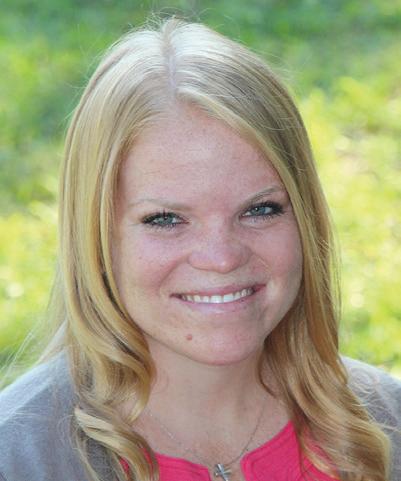
BY CHRISTI SHORT ROCHESTER, TEXAS
Dr. Gaylon Morgan, Ag and Environmental Research Director at Cotton Incorporated, manages weed-related sponsored projects at Cotton Incorporated, among many other discipline areas. He is optimistic about the future of weed science research and the next generation of scientists because of programs like FFAR.
“While we can work with these graduate students on specific projects to address weed management systems on the farm, their participation in FFAR gives them an opportunity to develop as leaders and researchers,” Morgan said. “When graduate students complete their programs and look for full-time positions, we want them to consider continuing to work in cotton. I believe supporting their participation in FFAR will help us secure the next generation of top-notch scientists in cotton.”
One of these students, Sarah Chu, a Ph.D. graduate student at Texas A&M University, focuses her research on weed seed destruction and the impact left-behind seeds can have on future weed emergence. Chu’s interest in an integrated weed management program stems from knowing that future success for farmers managing weeds in the field will have to come from more than herbicides alone.
Where the destruction of the weed seeds could take place in the cotton harvest process is one question Chu asked during her research. She has successfully tested running cotton gin trash through an impact mill to destroy and crush the seeds to produce weed-seed-free gin trash.
In a post-harvest approach, when cotton fields are typically shredded or mowed down, seeds from existing weed plants are put back into the soil. Chu is looking at what approach farmers could take in the field whether it is running these cuttings through a chopper, a controlled burn or other practices to destroy the seeds.
Chu was sponsored by Cotton Incorporated to participate in the FFAR program during her Ph.D. work. She credits the program with understanding project management, time management and collaboration with other researchers to reach larger
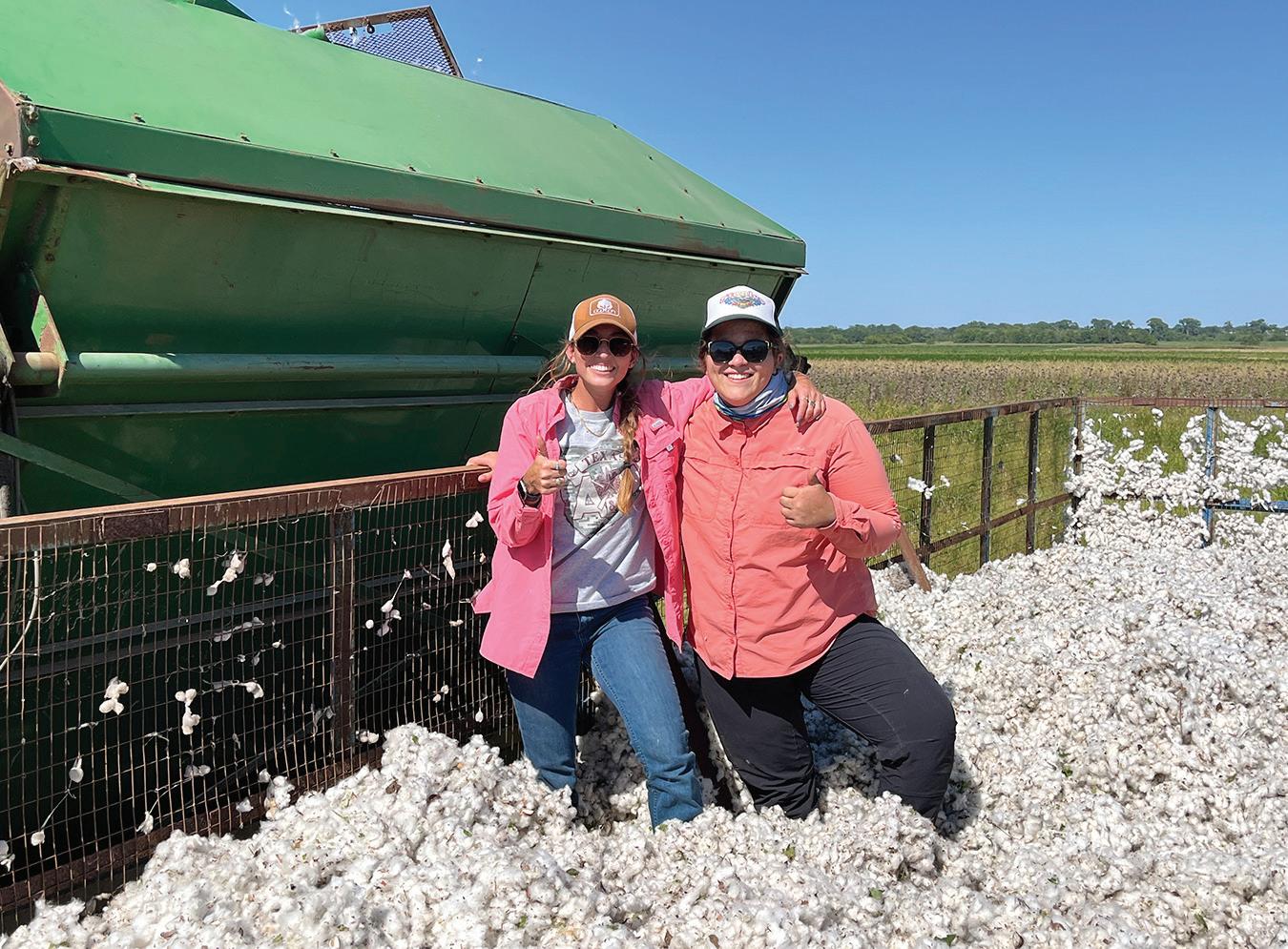
impact outcomes for growers.
Another interesting area of weed research in Texas is being led by Texas A&M Ph.D. graduate and FFAR program participant Dr. Sarah Kezar. Her focus has been on how different weed management practices impact weeds in the current year and how they impact the seed bank in future years. The practices that have measured results are layby application, hand removal, spot spraying, cover crops, early applications and a zero-tolerance approach.
This work helps growers determine the impacts their management practices will have on weed control in the current year and the following years. Her studies have shown programs with zero tolerance and targeted weed management can lead to higher lint yields and less weed emergence year after year. Cotton Incorporated provided funding for Kezar’s research and supported her participation in the FFAR program.
“I’m originally from the Midwest and didn’t know much about cotton when I started my research work, but I’m so thankful Cotton Incorporated took a chance on me to fund my research and my FFAR program. Cotton is my favorite crop to work with now,” Kezar said.
Cotton Incorporated’s Dr. Gaylon Morgan serves as a mentor for two other students, at Texas Tech University and Texas A&M University, currently in the FFAR program. This allows him to collaborate in research and stay abreast of innovations in the weed science space.
“I think supporting these students in their research studies and ensuring they develop the tools needed to succeed in their work is important to make sure we have future scientists that are capable and successful in working for cotton farmers in the future,” Morgan said. “It’s a great return on a financial investment when these top-notch student scientists become leaders in their field and choose to work on cotton for years to come.”
For more information from CI’s agricultural research department, go to https://cottoncultivated.cottoninc.com/.

Overall, July was good to our crop. Many fields received abundant rainfall during the month. In fact, one grower (and close friend) in east Alabama changed his prayer requests from “just pray for rain, whatever amount” to “just about an inch a week.” Not every field was so lucky, but much of the crop we have seen in late July and early August looks good. Insect pressure has ranged from intense to sporadic.
As the calendar moves to September, we should consider our last effective bloom date. Depending on where you are in Alabama and who you talk to, this date spans from about Aug. 20 through around Sept. 15. Obviously, the further north, the sooner that date approaches. Keep in mind that this date, whenever it is, represents a 50% chance the boll makes the picker.
Sometimes, we wait so long on the “top crop” that we can hurt what’s below, which represents the bulk of the lint. In terms of insect controls, plant bug applications can be terminated about node above white flower (NAWF) 2, while stink bugs can damage bolls until they are about 25 days old. As the crop matures, fewer susceptible bolls are in the field, and stink bug thresholds move to 30%-50% internal damage. We generally recommend a “clean up” spray before September when cotton begins to lay over. While sprayer tracks won’t run over every row, we would rather not run over any if possible.
With defoliation upcoming, we will have some things to consider. One complication will be regrowth. Some fields started “blooming out the top” in early July following June droughts. Since then, the crop has started growing vegetatively again. This regrowth may cause issues with defoliation. I will let the professionals make comments on products and rates. Just note that sprayer set up (spray volume, nozzles, pressure, etc.) can go a long way in the performance of defoliation and harvest aid products.
Follow along with our “Tales of Cotton Insects” on the Alabama Insects Blog (https://alabama-insects.blogspot.com/) for up-to-date information and recommendations for insect controls. If I can ever be of any help, please don’t hesitate to reach out and let me know. scottg@auburn.edu


A majority of the state’s cotton crop will be receiving an application of harvest preparation material, either defoliant or boll opener, or both over the next several weeks. A few things to keep in mind when making these applications include the maturity and the stress level of the crop. Application of harvest prep materials is really our effort to stimulate and enhance the natural process of crop senescence and leaf drop. Applications of harvest prep materials applied prematurely may lead to poor defoliation and increased leaf trash in seed cotton or the opening of immature bolls thus degrading overall fiber quality.
A general rule of thumb that has proven effective in timing harvest prep applications is that of estimating percent open boll. When 60% of the bolls are open or cracked, then a true defoliant can safely be applied with effective results. Open boll percentages can be effectively estimated by counting the number of nodes above the upper-most first position cracked boll (NACB) to the uppermost harvestable boll. A percent open boll of 60% coincides with a NACB value of 4.
The other factor to consider is crop stress level. Remember that the application of defoliant is an attempt to enhance the already progressing physiological process of senescence. If the crop is too stressed when the defoliant is applied, the physiological activity of the plant has diminished to the point that the plant does not effectively assimilate the chemical defoliant. Under this scenario, abscission layers do not properly form, resulting in leaves that “stick” on the plant and increased leaf content of the harvested seed cotton. On the other hand, if the plant is too lush and actively growing, the defoliant application will be much less effective.
A general rule of thumb is that a harvest prep application should be made at approximately two times the final irrigation interval. This interval may vary depending on weather and soil water-holding capacity. For more information and specifics regarding harvest prep and defoliation, go to extension.arizona.edu/crops-soils. rnorton@cals.arizona.edu

In Georgia, August and September can make or break a cotton crop. One of the worst things that I can hear on the news or see on social media is when folks start throwing around the “H-word.” I’m currently sitting in my office staring out the window as Hurricane Debby hovers over Georgia. I hope this is the only storm that makes its way across Georgia this season!
As we are approaching the finish line on this crop, there are a few things to keep in mind. First, the crop in Georgia is ahead of schedule. Many may think that because we were so delayed in planting that we are still behind, but that is not the case. Based on average growing degree days we are certainly ahead of schedule, and some of our later cotton may even be 10 days ahead. Why bring this up?? It is important to keep an eye on this crop and how it is progressing — get out there and check it because it is likely progressing faster than you think. My friends in the peanut business may not like this, but we may even have an opportunity to pick some cotton before peanuts this season.
Other things to keep an eye on as we are approaching the finish line are foliar diseases (primarily areolate mildew) and some insect pests. Make sure to treat when needed and not when thresholds aren’t met.
If you have questions about these topics or anything else, feel free

to reach out to myself, other members of the cotton team or your local county Extension agent. We are here to help! camphand@uga.edu

As we move into the latter portion of the growing season, we begin to look toward cotton harvest. In Missouri, we basically have two different cotton crops. Much of the early planted cotton has reached cutout, and maturing bolls will begin to open over the next few weeks, while the later-planted cotton has yet to reach cutout and is still fruiting on the upper part of the plant.
Rainfall in our area has been nonexistent in mid- to late-July; therefore, many producers were irrigating the crop at that time. I believe we will see a number of defoliation applications begin in early to mid-September for the early crop, but we will need heat units pushing into October for the late crop that we have.
Triggering a defoliation generally begins at five nodes above cracked boll, and it is important to pay attention to high daytime temperatures and nighttime temperatures when selecting harvest aid products in our area. Any hormonal application will be reduced when nighttime temperatures fall below 65 degrees Fahrenheit, and herbicidal products can cause sticking of leaves when we have high daytime temperatures at the time of application. brwilson@missouri.edu

As I write this on Aug. 4, 2024, summer is showing no signs of loosening its grip, and hot, sunny days rule the forecast. It has a been a hot and dry summer for the most part, but some regions of the state have been fortunate enough to get some timely rains. I always get the question, “How does the crop look in Mississippi?” And it seems that I always have the same answer: “Well, it depends on where you are standing.” There is some truth to that with reasons ranging from planting date, rainfall and fertility. In 2024, cotton
planted during the optimal window of May 1 – May 10, including late April, appears to be superior to cotton planted later in May. Insect pressure, especially plant bugs, has been unusually light this year, and fruit retention is as high as I’ve seen in recent years. Most of the cotton is less than 3 NAWF and almost past the threat of economic injury from insect pests. Late in the season, cotton often looks like its been through battle, and it has to some degree. Often times, late-season disease complexes form on the leaves causing defoliation. Drought-stressed leaves appear leathery and overall appearance is not as lush. All things considered, this means we are nearing defoliation or harvest. As August finishes up the crop, we can hope for hot sunny days and maybe one timely rain. Oh yeah, and a little mercy from the tropics! bkp4@msstate.edu

As I write this on July 26, the crop condition in North Carolina has drastically improved. The ultra-hot and dry June certainly impacted our yield potential, as early to mid-May-planted cotton entered the bloom period adversely short.
Later-planted cotton was also impacted but to a lesser degree. Thankfully, rains came to most areas in the state in very late June or early July as blooming began, and in most areas, rains have been plentiful since then. Some may consider them excessive; however, many creeks and ponds needed refilling even when the crop demands were met. Likewise, we needed somewhat excessive rains to prevent this crop from cutting out abruptly, and thankfully, that has happened.
At this point in time, our yield potential is quite good. That’s not to say the dry June hasn’t cost us….it has. But we still have potential for a great crop. As is the case in most years, August weather will dictate overall yield potential. A few timely rains in August without excessively hot temperatures, to deplete such moisture, will go a long way for our yields. Then we have to worry about September and October. We badly need — as we always do — a warm and sunny September without excessive
rains, prolonged cloudy weather or tropical events. Although it’s too early to tell how much of a top crop we’ll have, in some cases, it may be of interest to growers to pursue a top crop. Recent research has shown that in relatively average fall temperatures, we can make blooms as late as Sept. 5 or Sept. 10 into harvestable bolls IF we defoliate in mid-October with a couple of weeks of a few heat units remaining before first frost. This of course assumes we don’t have abnormally cool weather in September nor an early frost in October.
Making a top crop really only concerns cotton that is either planted very late (early June) or in cases where the bottom crop is less than ideal and conditions in August or early September have favored the development of a strong top crop. At this time, the potential for this is unknown. guy_collins@ncsu.edu
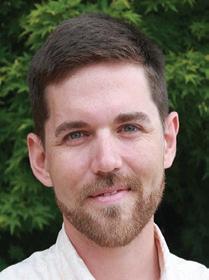
As I write this on the fifth of August, our earliest planted acres are very near physiological cutout, and our latest planted acres have been blooming for 10-14 days. By the time you read this during the first week of September, those with April cotton will likely note cracked bolls threatening to break mid-canopy.
As we look toward defoliation, I would remind you that we have two distinctly different crops this year, and while both have potential to be very good crops, we should not try to lump the latest planted acres in with the earliest planted acres. I fully expect some acres to be ready for their first shot of defoliant during mid-September.
In contrast, a large portion of our acres will need a favorable October to finish out the top third of our crop. There will be a strong urge to not park the sprayer and/or the picker and “keep rolling.” Resist! While we must keep a close eye on the forecast, rushing the latest crop will most likely reduce our returns.
It has been several years since “preconditioning” shots have been pushed in this area, but I can feel it coming this year. Our defoliants work by contact, not translocation. The leaves that will intercept the defoliant are the most immature and the most important to developing, immature bolls.
“Preconditioning” shots applied under the pretense of pushing maturity are sure to disappoint. When you decide to defoliate, do so with intent. I’ll be updating news.utcrops.com with concoctions that work as conditions change through the fall. traper@utk.edu

As I write this in early August, many growers in Texas are beginning to put together plans for harvesting the 2024 cotton crop. As of the first week of August, the Corpus Christi, Texas Classing Office has classed nearly 55,000 bales thus far from the cotton harvest already underway in the Lower Rio Grande Valley and Coastal Bend.
The month of July brought considerable rainfall amounts to several parts of South, East and Central Texas, along with Hurricane Beryl making landfall in the Upper Gulf Coast and pushing through the eastern portion of Texas. The most significant storm damage occurred in Matagorda and Wharton counties, but neighboring counties also sustained considerable crop damage as well. Late July rains didn’t do any favors for open cotton along the Texas Gulf Coast, and reports of seed sprouting in the boll spanned from the Lower Rio Grande Valley to the Upper Gulf Coast.
Throughout the months of August, September and October, growers will be keeping a close eye on the Atlantic and Gulf of Mexico as tropical weather systems typically ramp up during these months. Chemical
harvest aids serve many purposes for preparing the crop to harvest, and expediting the time to harvest can be one very important benefit to Texas producers this time of year. While harvesting your 2024 cotton crop may still be a way off depending on where you farm in Texas, developing a chemical defoliation strategy and ensuring that all application equipment is operating properly now is a great first step to getting ahead of the curve. bmcknight@tamu.edu

West Texas growers seemingly just finished up stand establishment and weed control, and suddenly, our topic today is “Preparing the Crop for Harvest!” Such is the season in this part of the belt. We are generally blessed to have few insect problems in West Texas, so not much emphasis is paid to insect control cut-off thresholds. Instead, we are more focused on irrigation termination dates, especially after the hot, dry August that is forecast as of this writing for much of the region.
Our last effective blooms range from mid-August in the northwest (higher elevation, higher latitude) portions of the high plains to late-August for the southernmost areas of the high plains. While most West Texans have seen the occasional bloom in early September make it to a harvestable boll, those late-maturing bolls are generally very small and have very low micronaire.
So while it is tempting to push the envelope to chase “phantom” bolls and keep irrigating at full capacity to stretch the bloom period to early September, I recommend against it, as it is a poor use of water, and could potentially cause a deterioration in fiber quality, both in terms of low micronaire from less mature bolls as well as potential leaf trash from late-season vegetative growth. Plus, these late-season bolls don’t contribute significantly to lint yield.
General rules of thumb for irrigation termination include 350-400 DD60s after cutout (for subsurface drip, LEPA pivots or furrow-irrigated fields), or 10% to 20% open boll for pivots that have spray drops (LESA or MESA). For most West Texas fields, this equates to the first week of September. However, it gets tricky if we have a dry August, and there is no rain in the forecast for early September. In those situations, the termination decision is on a field-by-field basis, as growers need to take into account soil moisture and the forecast at that time. There is no straightforward answer, unfortunately.
After terminating irrigation decisions have been made, the next major decision includes harvest aids. I’d like to report that choosing harvest aids for cotton in West Texas has become easier, but that is not the case. Harvest aid timing and chemistry choice involves a lot of art based on science. The science behind abscission and boll dehiscence has not changed, and much is understood. However, the complications stem from the interactions with weather and crop conditions. Firsthand experience should be highly emphasized; that is, growers’ experiences with various products and various timings on individual fields is a key piece of information.
If you have a field that has high yield potential, don’t sacrifice yield and quality by skimping on harvest aids. Conversely, if you have a dryland field that has low yield potential, waiting for a freeze is a legitimate economic strategy in West Texas. Because we predominately use stripper harvest in West Texas, I caution growers about applying harvest aid advice from your buddies in the picker parts of the Cotton Belt. We truly have very unique harvest preparation conditions. For more information on harvest aids for West Texas, see these two factsheets: https://lubbock. tamu.edu/files/2022/08/2022-Texas-High-Plains-Cotton-Harvest-AidGuide-2.pdf and https://extension.okstate.edu/fact-sheets/print-publications/pss/2021-oklahoma-cotton-harvest-aid-guide-pss-2182.pdf. ken.lege@ag.tamu.edu
BY GABRIELLE BELLELO LSU AGCENTER
Gloomy weather forced the LSU AgCenter Northeast Research Station to move its cotton and grain field day indoors — but there were few complaints from station staff and farmers who attended the event. Their fields received a much-needed rain amid a dry spell in the area.
As the rain fell outside, AgCenter personnel told attendees about several of their projects at the station. Many of these efforts center on best management practices and are funded by a grant from the Patrick F. Taylor Foundation.
Dennis Burns, an AgCenter agent and research coordinator at the station, said soil health — a key component of the Taylor grant work — is crucial.
“Everything we do here depends on the soil,” Burns said.
James Hendrix, an AgCenter agent involved in the grant project, emphasized the importance of the research being done at the station.
“We are testing best management practices for specific site areas because what works in one location may not necessarily be effective for another,” Hendrix said.
One focus of the grant is cover crops, which are typically grown in the off season. They can add nutrients to the soil,

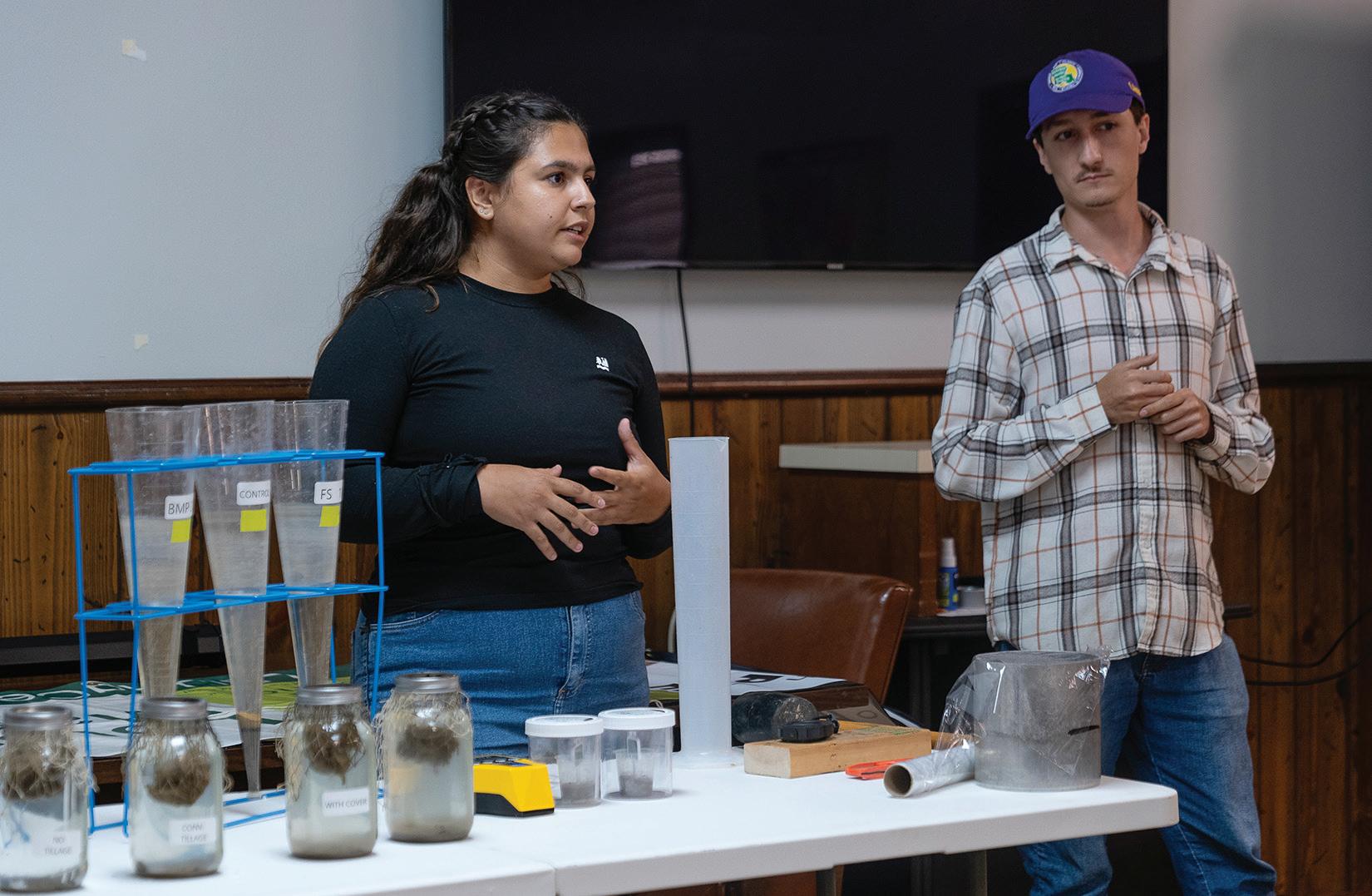
prevent erosion and provide other benefits for soil health.
At the station, Hendrix and his colleagues are testing various cover crops in different soil types.
Hendrix also talked about the current seeding rates recommended by the Natural Resources Conservation Service for crops that are commonly used to cover the soil, such as cereal rye, clover and vetch. These recommendations are based on those crops being used as cattle forages, which require higher seeding rates, rather than covers.
“We have been doing research at three locations for the past three years to come up with LSU AgCenter recommendations for seeding rates for cover crops,” Hendrix said.
The updated, lower rates have the potential to save growers money while still generating an ideal amount of biomass, he said. The new recommendations are set to be released to the public soon.
“It is going to save farmers a lot of money, and it is going to help the NRCS get more people involved in conservation programs,” Hendrix said.
Brazilian Researchers Contribute Field day attendees also heard from two visiting scholars from Brazil: Maria Salvador Santos and Leonardo Rezende, who arrived at the station in May. They will stay for a year to work on various research trials for the Taylor grant.
They gave a presentation on the tools they have been using to assess how cover crops as well as conventional tillage and no tillage systems affect the stability of soil and water infiltration rates.
“It is important to have nutrients cycling back to the plant and to improve soil structure by keeping the soil with organic matter. This helps with plant growth and production,” Santos said about soil aggregate stability.
During their time in Louisiana, Santos and Rezende will gain hands-on experience operating research equipment, setting up plots and planning research trials. They will also assist in planting and harvesting activities.
Other items on the field day program included a presentation on row rice from Burns as well as updates on weed science, entomology and various crops.
On July 2, 2024, the Occupational Safety and Health Administration published a proposed rule designed to protect workers from illness and injury associated with heat exposure. This proposed rule follows an “Advanced Notice of Proposed Rulemaking” that goes back to 2021. This proposed rule has been expected for some time.
Since the ANPRM, OSHA has had a National Emphasis Program on heat injury and illness, and they’ve had materials on their website for several years before that. When the NEP came out and the ANPRM was published, OSHA targeted a few industries for initial enforcement. Two of those were warehousing and agriculture.
In the first couple of years of the NEP, at least 13 gins were “randomly” selected in one region for inspection under the heat NEP. Their association had worked with the gins in the region to get materials in the hands of those gins and raise awareness, and no citations for heat were written.
This begs the question “citations for what?” There was no standard against which to write a citation. They were attempting to write citations on the “General Duty Clause.” We’ve discussed the General Duty Clause several times before, but in short, it means if you know something is a hazard, and there’s a way to mitigate it, you have a duty to fix it — no standard needed.
The newly proposed Heat Injury and Illness standard contains a long list of things that employers need to do to comply. These steps are based on trigger levels.
If any employees are required to work in an environment with a heat index of 80 degrees Fahrenheit for 15 min or more, the employer must take certain steps including having a Heat Illness and Injury Prevention Plan (HIIPP). Also required are things like heat index monitoring and employee training. The details of these programs would require way more space than is available here.
A heat index above 90 degrees F would be a “High Heat Trigger.” Additional steps would have to be observed including monitoring the heat index or wet bulb globe temperature, implementing an observation or buddy system and prescribed breaks of 15 min every two hours.
Also included in the standard are acclimatization procedures for getting new or newly returning workers used to working in


the heat. This may limit the duties of new employes for some period until they’re used to the heat.
This proposed rule applies to indoor and outdoor work, and we expect it will apply to agriculture and warehousing as well

As of this writing, the rule has not been published in the Federal Register, so we don’t have an effective date or even know when comments can be sent. To prepare and get more information, go to www.osha.gov/heat for the materials you can use today to get started on your program.
There you will find a lot of very good and well written information you can use and share with your employees. Make sure you have someone on staff trained to recognize and treat someone with heat-related illnesses and particularly watch those new employees as they get used to working in the heat.
Yeah, we know we live in the South. We could end up with a heat index above 80 degrees for the vast majority of the year. We still need to pay attention to this proposed rule. Take steps today to get ahead of it and document the things you’re already doing to keep your employees safe from heat injuries and illnesses.
Dusty Findley, CEO of the Southeastern Cotton Ginners Association, contributed this article. Contact him at 706-344-1212 or dusty@southern-southeastern.org.
Dr. Calvin B. Parnell was a professor at Texas A&M for many years. He was a key part of the development of the cotton module builder and the 1D3D cyclone. Dr. Parnell was very

passionate about the cotton ginning industry.
The Wesson Family Foundation has donated $50,000 to establish the Dr. Calvin B. Parnell Faculty Fellowship. They also established the Wesson Family Foundation Matching Fund for $100,000, available until Dec. 31, 2024. Expenditures from this non-endowed fund will be used to match donations of $2,000 and above given to the Dr. Calvin B. Parnell Faculty Fellowship.
To date, about $24,000 of the matching funds have been used, leaving roughly $76,000 in matching funds available to reach the overall goal of $250,000 for the Endowed Fellowship honoring Dr. Parnell. Please help us in achieving this goal by the end of the year.
The intent of the Dr. Calvin B. Parnell Faculty Fellowship is to recognize excellence in performance as a Biological and Agricultural Engineering faculty member, with particular emphasis on mentoring departmental students, as Dr. Calvin B. Parnell effectively did during his years on the Texas A&M faculty.
If you would like to donate an amount lower than $2,000, but still have it be matched, the Cotton Industry Support Group (CISG), is a 501(c)(3) organization for tax purposes, and Kelley is the Chairman of CISG. If your donation is less than $2,000 and you send it to CISG, CISG will pool your funds with other donations and send you a charitable donation receipt for your taxes.
Once CISG receives $2,000 in donations, they will donate to the Texas A&M Foundations for the Dr. Calvin B. Parnell Fellowship so we can maximize our use of the matching funds that the Wesson Family has so graciously provided.
Donations to CISG can be mailed to the TCGA office. Go to https://www.txamfoundation.com to give directly to the Texas A&M Foundation.
TCGA provided this information.

While sweeping the floor of our farm shop one October morning, I was fondly reminded of the late Julius Bembry. Enough dirt had accumulated under my watch to start a small garden. That never happened when Julius was around. Sweeping up was part of his weekly routine.
His parents moved to my grandfather Jim Joiner’s farm when Julius was six months old. As a young man, he worked with my Uncle Ray for a while, then spent over 50 years helping Daddy. He was a fine Christian gentleman and a dear friend to multiple generations of our family.
There were times of the year that sweeping the shop was put on hold. Planting season came with long hours, and the days of harvesting often extended past sundown. Usually, however, farm work ended at noon on Saturday. About 11:30, Julius would grab a broom and sweep the concrete floor.
A third sweeping-related memory surfaced of my friend Larry Abbott. He died in 2018 at age 70 from ongoing health issues. Larry walked with a pronounced limp, and one of his arms was severely undeveloped and almost useless. Despite those limitations, he kept the floors at the hospital in Vienna spotless for 21 years.
Larry was constantly going up and down those tiled hallways. It was a common site to see him pushing a wide dust mop with an arm made strong from double duty. I never saw him when he wasn’t smiling and pleasantly taking pride in his work.
His exemplary attitude is one reason I sometimes think about Larry. The other is his simple approach to faith, a perspective he memorably conveyed one day at the bank.
I was sitting at my desk when Larry came into my office. He invited me to speak at a Brotherhood meeting at Mt. Vernon Baptist Church. I told him I would, then jestfully added, “Maybe I can think of something to talk about.”
With a big grin, Larry said he was sure I could. He headed toward the door but paused and turned around. He stepped back to my desk and innocently shared some advice that I still cherish. He said, “You could talk about something out of the Bible.”
“Sweeping the shop floor that October morning gave me a lot to think about.”
Julius liked a clean and orderly workspace. He’d make sure the hand tools were in the right place, knowing he’d need them again Monday morning. If they were greasy, he’d wash them in gasoline. Then he’d sweep the floor and lock the door.
Joiner’s Store also came to mind that morning. My sweeping experiences there were courtesy of one of Daddy’s brothers. Uncle Emmett hired me to help him while he was recovering from a car accident. I was 11 when I started and 12 when I quit. We got along fine, but he tended to have grouchy spells. I figured I could get by without the dollar a day for Saturday pay, which he held until month’s end.
Store work was, however, good training. I’d stock the shelves, fill orders, work the mechanical cash register, pump gas, wash his car and do the weekly sweeping. He kept red sawdust that I’d sprinkle on the wooden floor in the mornings. It came moistened with oil to help attract grime. After a few hours of foot traffic, the sawdust was ready to be collected.
That little moment has long been a source of inspiration. Religion can be complicated if we let it. So can church. Larry understood that faith at its best is simple.
Matthew 18:2-3 addresses that matter. “And Jesus called a little child unto him and set him in the midst of them. And said, ‘Verily I say unto you, except ye be converted, and become as little children, ye shall not enter into the kingdom of heaven.’”
Sweeping the shop floor that October morning gave me a lot to think about. Julius, Uncle Emmett and Larry are all gone, but each of them impacted my life in positive ways. Pleasant memories with meaningful lessons are a good combination. Reflecting on them was an unexpected reward for my long-delayed efforts in rounding up the dirt.
And as the stirred dust resettled to the floor, I decided it best to sweep a little bit more.
— Neil Joiner Vienna, Georgia gneiljoiner@gmail.com joinerscorner.com
Cotton Farming’s back page is devoted to telling unusual “farm tales” or timely stories from across the Cotton Belt. Now it’s your turn. If you’ve got an interesting story to tell, send a short summary to csmith@onegrower.com. We look forward to hearing from you.
The Cotton Research and Promotion Program's ongoing goal is to develop, fund and implement research and promotion designed to strengthen Upland cotton’s competitive position and to maintain and expand domestic and foreign markets and uses for cotton. At the farm level, the Cotton Research and Promotion Program is dedicated to agricultural research aimed at helping Upland cotton producers increase yields and improve profitability. At the fiber level, the Cotton Research & Promotion Program is working to increase the demand for cotton and cotton products worldwide.





































•Front-end loader or 3-point hitch










•Penetrates bales easily
•Durable 6” x 84” sharpened forks


•Adjustable stand for off-season storage










Co on F k Bale Handler Scan




•Proven performance - hundreds of thousands of bales moved over the last 10 years







•Stalk-free transport to your gin











8-Module Capacity

•Hydraulic Ramps Optional



•Platforms elevate 2 bales easily removable by loader

















